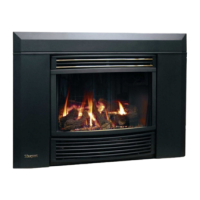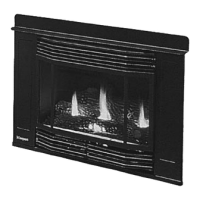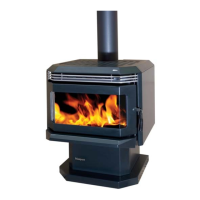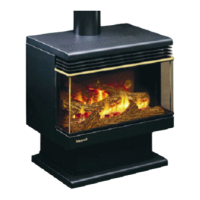Masport Inbuilt Gas Fireplace - 14 -
EIS Models
Assuming that there is a gas supply to the valve and
that the mains power is switched ON, the operating
sequence is as follows:-
1) The on/off switch on the LH side of the fascia is
switched to the “ON” position. This is the top
switch.
2) If the thermostat loop is in place across the
thermostat terminals, a 24 V signal will go to the
relay, which closes and sends a mains signal to the
igniter module to initiate the ignition sequence.
3) About 3 seconds after the ignition module is
activated, there will be a continuous spark at the
ignition electrodes.
4) If there is no spark, the On/Off switch needs to be
cycled to reset the ignition module at which time it
will repeat the ignition cycle.
5) If the spark stops before the burner ignites, again
the On/Off switch needs to be cycled to reset the
ignition module at which time it will repeat the
ignition cycle. Sometimes, with a new installation, it
will take several attempts to give sufficient time to
bleed air out of the pipeline.
6) As soon as the burner lights, the flame sensor will
signal the high-tension spark to stop.
7) The flame height can be controlled with the middle
rocker switch on the LH side of the fascia. Note that
flame size only changes between high and low.
8) While the fan speed can be pre-selected at this
time, using the lower rocker switch, the fan will not
start until the firebox has reached a reasonable
working temperature. The fan will start
automatically once this has been attained. (Usually
about 10 minutes, depending on the flame height).
SHUTDOWN PROCEDURE
Piccolo
1) Push the knob in momentarily and rotate clockwise
to the pilot position. To extinguish the pilot, push
the knob in and turn clockwise to the “OFF”
position. Do not force.
2) Disconnect all electric power and gas to the
appliance if service is to be performed.
EIS
1) Use the top rocker switch to turn off the main
burner.
2) Use the bottom rocker switch, if desired to turn off
the fan immediately. If not manually switched off
the fan will automatically turn off once the
appliance has cooled to a point where no more
useful heat can be produced.
3) Disconnect all electric power and gas to the
appliance if service is to be performed.
THE FIRST FEW FIRES
The first few fires in your stove are part of the curing
process. When first operated, the unit will release an
odour and the flames will appear orange caused by the
curing of the paint, the burning off of the starch in the
gas logs and the oils on the metal.
After several fires the starch in the logs may show as a
deposit inside the glass. If this film is not removed it
will bake on and may become very difficult to remove.
When the glass is cold, remove it (see page 11) and
clean the inside with a non-abrasive cleaner.
DO NOT ATTEMPT TO CLEAN THE GLASS WHILE
IT IS HOT. NEVER OPERATE THE UNIT WITH THE
GLASS REMOVED.
FAN OPERATION
Note: It is possible to use the fire with the fan not going
although for better air circulation and heat discharge
area temperature reduction using the fan is
recommended.
Piccolo
The fan operates by using the rocker switch on the left-
hand side of the fascia. To adjust the desired fan
speed, operate the rocker switch. The fan has 2
speeds, a high speed for more rapid air movement and
a low speed. The fan should not be used until the fire is
up to operating temperature, approximately 10mins.
The fan can be left running after the fire has been shut
down until it is circulating no more useful heat.
EIS Models
The fan operates by using the bottom of the 3 rocker
switches on the left-hand side of the fascia. To adjust
the desired fan speed, operate the rocker switch. The
fan has 2 speeds, a high speed for more rapid air
movement and a low speed.
NOTE: EIS models are fitted with a thermodisc fan
control. This means the fan will operate only when the
heater is up to operating temperature (approximately
10 minutes from start on high burn) and will stop
automatically once the heater has cooled down. This
is particularly useful when a thermostat is fitted, as the
fan will not be running unnecessarily. Because the

